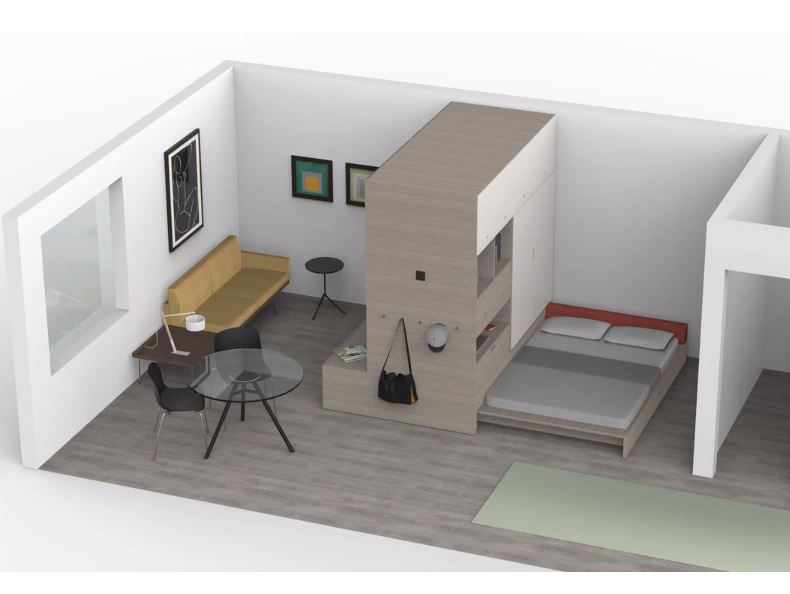Share This
Related Posts
Tags
Flexible Furniture
By Cutright Elizabeth on Jan 4, 2016 in Technology
Expandable furniture helps micro-apartment inhabitants make the most out of limited square footage with the push of a button.
Trundle beds and convertible couches may define making the most of a small living space, but what’s been lacking is automation and modernization. Enter Ori, robotic furniture that appears, and disappears, with the push of a button.
Modular Momentum
The brainchild of Hasier Larrea, Ori furniture takes the guesswork out of transformation, seamlessly morphing floor units and wall installations into beds and pop-out closets. Ori offers a full-scale bedroom with a retractable bed that can be changed into an office or a closet, along with a full media console/credenza. Other versions include a walk-in closet, couch and various flavors of storage space. All the systems can be integrated into new and existing floorplans, which allows the Ori system to fit comfortably into any new building development or retrofit.
During her tenure as the leader of the Architectural Robotics research area at the MIT Media Lab, Larrea married her robotics tech with Yves Behar design. The final product involves modular, transformable furniture Larrea and her team hope will debut early next year.
“Larson’s team at the Media Lab developed the technologies behind Ori as part of the CityHome research,” Larrea told Mashable in a recent interview. “Then we created some initial functional prototypes … and went to [designer] Yves Béhar to help us ‘transform’ this initial concept from a robot/machine to a customizable system that people would love to have in their homes.”
Space on Demand
Ori’s first piece available for purchase includes a trundle style bed that rolls out from the bottom of a large wall of shelves. Specially designed actuators, electronics and software created by researchers at MITs CityHome project allows Ori’s furniture to almost float above the floorboards as it shifts from one incarnation to the next. The entire unit can be configured with custom finishes, colors and materials.
Ori’s control panel is hard-wired with motion sensors triggered by the push of a button able to detect different levels of pressure; the harder the user presses down, the faster the furniture moves. Pre-set options create the opportunity to try out a variety of different configurations, allowing users to move trigger transformations depending upon mood and need. Users will also eventually be able to arrange their furniture via mobile app, which means apartment dwellers can shape a room remotely, so it’s ready to use when they return.
“Many people living in urban environments no longer have the luxury of space, or they are choosing to live in a smaller footprint,” says Ori designer Béhar, in a statement sent to Mashable. “What Ori does is maximize the functionality of a space; with robotic technology it creates a beautiful and transformative living and working environment that is unlike anything the world has seen.”
Private Spaces, Open Floors
Larrea’s goal to create effortless renovations means Ori furniture glides smoothly from one structure to the next. In a video highlighting Ori’s designs, apartment dwellers go about their day, casually altering their living spaces based on different activities. A wall descends or a desk replaces a bed, and a 350-square foot apartment suddenly feels twice the size.
“Guided by the principal that interior space, particularly in high-density urban innovation centers around the world, has become too expensive to be static and unresponsive, Ori’s breakthrough innovation, technology and design create dynamic environments that act and feel as though they are substantially larger,” declares the Ori Systems website.
“Through architectural robotics, Ori’s systems promise to liberate urban design, provide new user experiences, and unlock the potential of the places we increasingly want to live, work and play.”
Dynamic Environments
Over the summer, Ori will be delivered to pre-selected commercial and real estate developments in Boston, Seattle and Washington D.C. While the initial foray may be small, Larrea anticipates greater adoption as early as 2017.
“We are initially targeting multifamily real estate developers/building owners, mostly rentals,” Larrea says. “This may become available to consumers directly with the right distribution and manufacturing partnerships, but in the short term the idea is to start B2B.”
“Beyond the comfort and life-enhancing varied accommodations, Ori creates financial value for renters or owners; a studio becomes a one bedroom, for example,” adds Béhar. “The Ori system is also valuable for developers by immediately increasing the value of the home.”
